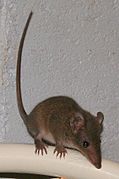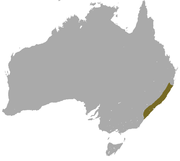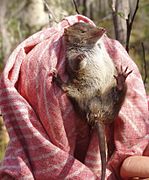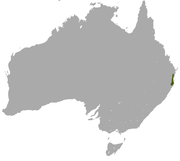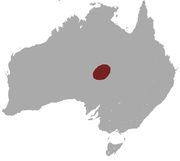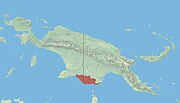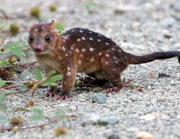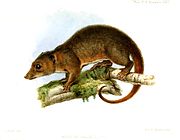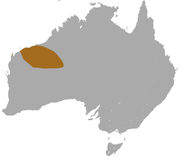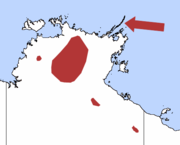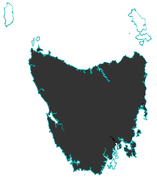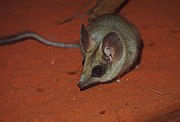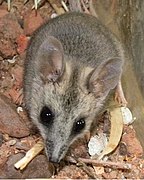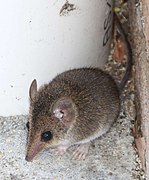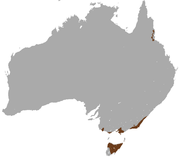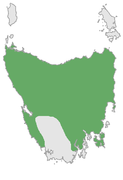Mammalian order of carnivorous marsupials
Species in Dasyuromorphia; clockwise from top left: thylacine , Tasmanian devil , numbat , fat-tailed dunnart , yellow-footed antechinus and tiger quoll Dasyuromorphia is an order of mammals comprising most of the Australian carnivorous marsupials . Members of this order are called dasyuromorphs, and include quolls , dunnarts , the numbat , the Tasmanian devil , and the extinct thylacine . They are found in Australia and New Guinea , generally in forests, shrublands , and grasslands , but also inland wetlands , deserts, and rocky areas. They range in size from the southern ningaui , at 4 cm (2 in) plus a 4 cm (2 in) tail, to the Tasmanian devil, at 80 cm (31 in) plus a 30 cm (12 in) tail, though the thylacine was much larger at up to 195 cm (77 in) plus a 66 cm (26 in) tail. Dasyuromorphs primarily eat invertebrates , particularly insects and arthropods , though most will also eat small lizards or other vertebrates. As the two largest species in the order, Tasmanian devils instead eat carrion of larger mammals in addition to insects, and the thylacine ate larger mammals and livestock. Most dasyuromorphs do not have population estimates, but the ones that do range from 700 to 100,000. The eastern quoll , northern quoll , dibbler , Tasmanian devil, and numbat are categorized as endangered species , while the thylacine was made extinct in 1936.
The seventy-two extant species of Dasyuromorphia are divided into two families : Dasyuridae , containing seventy-one species divided between the thirteen genera in the subfamily Dasyurinae and the four genera of the subfamily Sminthopsinae ; and Myrmecobiidae , containing the numbat. There is additionally the family Thylacinidae , containing the extinct thylacine. Dozens of extinct Dasyuromorphia species have been discovered, though due to ongoing research and discoveries the exact number and categorization is not fixed.[ 1]
Conventions
Conservation status codes listed follow the International Union for Conservation of Nature (IUCN) Red List of Threatened Species . Range maps are provided wherever possible; if a range map is not available, a description of the dasyuromorph's range is provided. Ranges are based on the IUCN Red List for that species unless otherwise noted. All extinct species or subspecies listed alongside extant species went extinct after 1500 CE, and are indicated by a dagger symbol "†".
Classification
The order Dasyuromorphia consists of two extant families , Dasyuridae and Myrmecobiidae . Dasyuridae is divided into two subfamilies: Dasyurinae , containing forty-three species in thirteen genera , and Sminthopsinae , containing twenty-seven species in four genera. Myrmecobiidae consists of a single species. Additionally, Dasyuromorphia contains the family Thylacinidae , whose only living member, the thylacine , was made extinct in 1936. Many of these species are further subdivided into subspecies. This does not include hybrid species or extinct prehistoric species.
Dasyuromorphs
The following classification is based on the taxonomy described by the reference work Mammal Species of the World molecular phylogenetic analysis , as supported by both the IUCN and the American Society of Mammalogists .[ 3]
Dasyuridae
Subfamily Dasyurinae
Genus Antechinus Macleay , 1841
Common name
Scientific name and subspecies
Range
Size and ecology
IUCN status and estimated population
Agile antechinus
A. agilis Dickman , Parnaby , Crowther & King , 1998Southern Australia
Size : 6–13 cm (2–5 in) long, plus 6–12 cm (2–5 in) tail[ 4] Habitat : Forest and shrubland[ 5] Diet : Arthropods and other invertebrates, as well as small vertebrates[ 6] LC [ 5]
Atherton antechinus
A. godmani (Thomas , 1923)
Northeastern Australia
Size : 9–16 cm (4–6 in) long, plus 9–14 cm (4–6 in) tail[ 7] Habitat : Forest[ 8] Diet : Invertebrates, as well as small vertebrates and carrion[ 6] LC [ 8]
Brown antechinus
A. stuartii Macleay , 1841Eastern Australia
Size : 6–19 cm (2–7 in) long, plus 6–16 cm (2–6 in) tail[ 4] Habitat : Forest[ 9] Diet : Invertebrates such as beetles, spiders, and cockroaches, as well as vertebrates such as placental mice and plants[ 10] LC [ 9]
Cinnamon antechinus
A. leo Dyck , 1980Northeastern Australia
Size : 6–19 cm (2–7 in) long, plus 6–16 cm (2–6 in) tail[ 4] Habitat : Forest[ 11] Diet : Invertebrates, as well as small vertebrates[ 6] LC [ 11]
Dusky antechinus
A. swainsonii (Waterhouse , 1840)
Southeastern Australia
Size : 8–19 cm (3–7 in) long, plus 7–13 cm (3–5 in) tail[ 4] Habitat : Forest and shrubland[ 12] Diet : Worms and insects as well as lizards, small birds, fruit, and plants[ 13] LC [ 12]
Fawn antechinus
A. bellus (Thomas , 1904)
Northern Australia
Size : 6–19 cm (2–7 in) long, plus 6–16 cm (2–6 in) tail[ 4] Habitat : Forest and savanna[ 14] Diet : Invertebrates, as well as small vertebrates[ 6] VU [ 14]
Subtropical antechinus
A. subtropicus Dyck , Crowther , 2000Eastern Australia
Size : 6–19 cm (2–7 in) long, plus 6–16 cm (2–6 in) tail[ 4] Habitat : Forest and shrubland[ 15] Diet : Invertebrates, as well as small vertebrates[ 6] LC [ 15]
Swamp antechinus
A. minimus (Geoffroy , 1803)
Southern Australia and Tasmania
Size : 6–19 cm (2–7 in) long, plus 6–16 cm (2–6 in) tail[ 4] Habitat : Forest, shrubland, grassland, and inland wetlands[ 16] Diet : Invertebrates, as well as small vertebrates[ 6] LC [ 16]
Tropical antechinus
A. adustus (Thomas , 1923)
Northern Australia
Size : 7–14 cm (3–6 in) long, plus 6–11 cm (2–4 in) tail[ 17] Habitat : Forest[ 18] Diet : Moths, beetles, and other insects, as well as spiders, worms, and small vertebrates such as skinks and frogs[ 18] LC [ 18]
Yellow-footed antechinus
A. flavipes (Waterhouse , 1838)
A. f. flavipes
A. f. rubeculus
Southwestern and eastern Australia
Size : 8–17 cm (3–7 in) long, plus 6–16 cm (2–6 in) tail[ 4] Habitat : Forest, savanna, shrubland, and inland wetlandsDiet : Insects as well as nectar, mice, and birds[ 6] LC
Genus Dasycercus Peters , 1875
Common name
Scientific name and subspecies
Range
Size and ecology
IUCN status and estimated population
Brush-tailed mulgara
D. blythi (Waite , 1904)
Western Australia
Size : 12–23 cm (5–9 in) long, plus 6–13 cm (2–5 in) tail[ 20] Habitat : Shrubland, grassland, and desert[ 21] Diet : Invertebrates, reptiles, and small mammals[ 21] LC [ 21]
Crest-tailed mulgara
D. cristicauda (Krefft , 1867)
Central Australia
Size : 12–22 cm (5–9 in) long, plus 7–13 cm (3–5 in) tail[ 22] Habitat : Shrubland, grassland, and desert[ 23] Diet : Insects, arthropods, and small vertebrates[ 22] NT [ 23]
Genus Dasykaluta Archer , 1982
Common name
Scientific name and subspecies
Range
Size and ecology
IUCN status and estimated population
Little red kaluta
D. rosamondae (Ride , 1964)
Western Australia
Size : 9–11 cm (4–4 in) long, plus 5–7 cm (2–3 in) tail[ 24] Habitat : Grassland[ 25] Diet : Insects, lizards, mice, and other small vertebrates[ 24] LC [ 25]
Genus Dasyuroides Spencer , 1896
Common name
Scientific name and subspecies
Range
Size and ecology
IUCN status and estimated population
Kowari
D. byrnei Spencer , 1896Northeastern Australia
Size : 13–18 cm (5–7 in) long, plus 11–14 cm (4–6 in) tail[ 26] Habitat : Shrubland and desert[ 27] Diet : Invertebrates, as well as rodents, birds, eggs, lizards, and carrion[ 26] VU [ 27]
Genus Dasyurus Geoffroy , 1796
Common name
Scientific name and subspecies
Range
Size and ecology
IUCN status and estimated population
Bronze quoll
D. spartacus Dyck , 1987Southern New Guinea
Size : 30–38 cm (12–15 in) long, plus 25–29 cm (10–11 in) tail[ 28] Habitat : Savanna[ 29] Diet : Insects and small vertebrates[ 30] NT [ 29]
Eastern quoll
D. viverrinus (Shaw , 1800)
Tasmania
Size : 35–45 cm (14–18 in) long, plus 21–30 cm (8–12 in) tail[ 31] Habitat : Forest, shrubland, and grassland[ 32] Diet : Insects, as well as small marsupials, rats, rabbits, mice, carrion, and plants[ 31] EN [ 32]
New Guinean quoll
D. albopunctatus Schlegel , 1880Northern New Guinea
Size : 22–35 cm (9–14 in) long, plus 21–31 cm (8–12 in) tail[ 33] Habitat : Forest[ 34] Diet : Insects and small vertebrates[ 30] NT [ 34]
Northern quoll
D. hallucatus Gould , 1842Northern Australia
Size : 12–31 cm (5–12 in) long, plus 12–31 cm (5–12 in) tail[ 35] Habitat : Forest and shrubland[ 36] Diet : Insects, as well as small mammals, birds, frogs, reptiles, and fruit[ 35] EN [ 36]
Tiger quoll
D. maculatus (Kerr , 1792)
Eastern Australia
Size : 35–76 cm (14–30 in) long, plus 34–55 cm (13–22 in) tail[ 37] Habitat : Forest and shrubland[ 38] Diet : Greater gliders , rabbits, bandicoots , red-necked pademelons , common ringtail possums , and cuscuses , as well as insects, reptiles, and birds[ 37] NT [ 38]
Western quoll
D. geoffroii Gould , 1841Southwestern Australia
Size : 36–46 cm (14–18 in) long, plus 22–30 cm (9–12 in) tail[ 39] Habitat : Forest, shrubland, and desert[ 40] Diet : Small mammals, birds, reptiles, and invertebrates, as well as plants[ 40] NT [ 40]
Genus Murexia Tate , Archbold , 1937
Common name
Scientific name and subspecies
Range
Size and ecology
IUCN status and estimated population
Black-tailed dasyure
M. melanurus (Thomas , 1899)
New Guinea
Size : 9–16 cm (4–6 in) long, plus 10–17 cm (4–7 in) tail[ 41] Habitat : Forest[ 42] Diet : Insects and spiders, as well as worms and small vertebrates[ 41] LC [ 42]
Broad-striped dasyure
P. rothschildi Tate , 1938Eastern New Guinea
Size : 12–17 cm (5–7 in) long, plus 14–19 cm (6–7 in) tail[ 43] Habitat : Forest[ 44] Diet : Invertebrates and small vertebrates, including birds[ 43] NT [ 44]
Habbema dasyure
M. habbema (Tate , Archbold , 1941)
Central New Guinea
Size : 11–13 cm (4–5 in) long, plus 10–16 cm (4–6 in) tail[ 45] Habitat : Forest and grassland[ 46] Diet : Insects, worms, and small vertebrates[ 45] LC [ 46]
Long-nosed dasyure
P. naso (Jentink , 1911)
Central New Guinea
Size : 12–20 cm (5–8 in) long, plus 10–18 cm (4–7 in) tail[ 43] Habitat : Forest[ 47] Diet : Insects, spiders, and worms[ 43] LC [ 47]
Short-furred dasyure
M. longicaudata (Schlegel , 1866)
New Guinea
Size : 13–29 cm (5–11 in) long, plus 14–29 cm (6–11 in) tail[ 48] Habitat : Forest[ 49] Diet : Insects[ 48] LC [ 49]
Genus Neophascogale Stein , 1933
Common name
Scientific name and subspecies
Range
Size and ecology
IUCN status and estimated population
Speckled dasyure
N. lorentzi (Jentink , 1911)
Central New Guinea
Size : 16–23 cm (6–9 in) long, plus 17–22 cm (7–9 in) tail[ 55] Habitat : Forest and grassland[ 56] Diet : Insects[ 55] LC [ 56]
Genus Parantechinus Tate , 1947
Common name
Scientific name and subspecies
Range
Size and ecology
IUCN status and estimated population
Dibbler
P. apicalis (Gray , 1842)
Southwestern Australia
Size : 14–15 cm (6 in) long, plus 9–12 cm (4–5 in) tail[ 24] Habitat : Shrubland[ 57] Diet : Invertebrates, as well as plants[ 57] EN [ 57]
Genus Phascogale Temminck , 1824
Common name
Scientific name and subspecies
Range
Size and ecology
IUCN status and estimated population
Brush-tailed phascogale
P. tapoatafa (Meyer , 1793)
Northern, western, and eastern Australia (in green and yellow)
Size : 16–23 cm (6–9 in) long, plus 17–22 cm (7–9 in) tail[ 58] Habitat : Forest and savanna[ 59] Diet : Invertebrates, as well as nectar[ 59] NT [ 59]
Red-tailed phascogale
P. calura Gould , 1844Southwestern Australia
Size : 9–13 cm (4–5 in) long, plus 11–15 cm (4–6 in) tail[ 60] Habitat : Forest, savanna, and shrubland[ 61] Diet : Insects and spiders, as well as small mammals, birds, and lizards[ 60] NT [ 61]
Northern brush-tailed phascogale
P. pirata Thomas , 1904Northern Australia (current range in dark green)
Size : 15–21 cm (6–8 in) long, plus 18–21 cm (7–8 in) tail[ 60] Habitat : Forest[ 62] Diet : Insects and spiders, as well as small mammals, birds, and lizards[ 60] VU [ 62]
Genus Phascolosorex Matschie , 1916
Common name
Scientific name and subspecies
Range
Size and ecology
IUCN status and estimated population
Narrow-striped marsupial shrew
P. dorsalis (Peters , Doria , 1876)
P. d. brevicaudata
P. d. dorsalis
P. d. whartoni
Central New Guinea
Size : 13–17 cm (5–7 in) long, plus 11–16 cm (4–6 in) tail[ 63] Habitat : Forest[ 64] Diet : Insects and arthropods, as well as small vertebrates[ 65] LC [ 64]
Red-bellied marsupial shrew
P. doriae (Thomas , 1886)
Western New Guinea
Size : 11–23 cm (4–9 in) long, plus 11–20 cm (4–8 in) tail[ 63] Habitat : Forest[ 66] Diet : Believed to be insects and arthropods, as well as small vertebrates[ 65] LC [ 66]
Genus Pseudantechinus Tate , 1947
Common name
Scientific name and subspecies
Range
Size and ecology
IUCN status and estimated population
Alexandria false antechinus
P. mimulus (Thomas , 1906)
Central Australia
Size : 6–12 cm (2–5 in) long, plus 5–13 cm (2–5 in) tail[ 67] Habitat : Savanna, shrubland, grassland, and rocky areas[ 68] Diet : Insects[ 67] NT [ 68]
Fat-tailed false antechinus
P. macdonnellensis (Spencer , 1896)
Central Australia
Size : 7–11 cm (3–4 in) long, plus 6–9 cm (2–4 in) tail[ 69] Habitat : Savanna, shrubland, rocky areas, and desert[ 70] Diet : Insects, as well as other invertebrates and rodents[ 69] LC [ 70]
Ningbing false antechinus
P. ningbing Kitchener , 1988Northern Australia
Size : 6–12 cm (2–5 in) long, plus 5–13 cm (2–5 in) tail[ 67] Habitat : Forest, savanna, shrubland, and rocky areas[ 71] Diet : Insects[ 67] LC [ 71]
Rory Cooper's false antechinus
P. roryi Cooper , Aplin , Adams , 2000Northwestern Australia
Size : 6–12 cm (2–5 in) long, plus 5–13 cm (2–5 in) tail[ 67] Habitat : Desert and rocky areas[ 72] Diet : Insects[ 67] LC [ 72]
Sandstone false antechinus
P. bilarni (Johnson , 1954)
Northern Australia
Size : 6–12 cm (2–5 in) long, plus 5–13 cm (2–5 in) tail[ 67] Habitat : Forest, savanna, and rocky areas[ 73] Diet : Insects[ 67] LC [ 73]
Woolley's false antechinus
P. woolleyae Kitchener , 1988Western Australia
Size : 6–12 cm (2–5 in) long, plus 5–13 cm (2–5 in) tail[ 67] Habitat : Desert, rocky areas, and shrubland[ 74] Diet : Insects[ 67] LC [ 74]
Genus Sarcophilus F. Cuvier , 1837
Common name
Scientific name and subspecies
Range
Size and ecology
IUCN status and estimated population
Tasmanian devil
S. harrisii (Boitard , 1841)
S. h. dixonae
S. h. harrisii
Tasmania
Size : 52–80 cm (20–31 in) long, plus 23–30 cm (9–12 in) tail[ 75] Habitat : Forest, shrubland, grassland, and non-aquatic caves and subterranean habitats[ 76] Diet : Carrion, as well as insects, larvae, snakes, and plants[ 75] EN [ 76]
Subfamily Sminthopsinae
Genus Antechinomys Krefft , 1867
Common name
Scientific name and subspecies
Range
Size and ecology
IUCN status and estimated population
Kultarr
A. laniger (Gould , 1856)
Central Australia
Size : 7–10 cm (3–4 in) long, plus 10–15 cm (4–6 in) tail[ 77] Habitat : Savanna, shrubland, grassland, and desert[ 78] Diet : Spiders, cockroaches, and crickets[ 79] LC [ 78]
Genus Ningaui Archer , 1975
Common name
Scientific name and subspecies
Range
Size and ecology
IUCN status and estimated population
Pilbara ningaui
N. timealeyi Archer , 1975Northwestern Australia
Size : 4–8 cm (2–3 in) long, plus 5–10 cm (2–4 in) tail[ 80] Habitat : Grassland, rocky areas, and desert[ 81] Diet : Insects, other invertebrates, and possibly small vertebrates[ 80] LC [ 81]
Southern ningaui
N. yvonnae Kitchener , Stoddart , Henry , 1983Southern Australia
Size : 4–6 cm (2 in) long, plus 4–6 cm (2 in) tail[ 82] Habitat : Grassland and shrubland[ 83] Diet : Insects and arthropods, as well as reptiles[ 82] LC [ 83]
Wongai ningaui
N. ridei Archer , 1975Central Australia
Size : 4–8 cm (2–3 in) long, plus 5–10 cm (2–4 in) tail[ 80] Habitat : Savanna, shrubland, and grassland[ 84] Diet : Insects, other invertebrates, and possibly small vertebrates[ 80] LC [ 84]
Genus Planigale Troughton , 1928
Common name
Scientific name and subspecies
Range
Size and ecology
IUCN status and estimated population
Common planigale
P. maculata (Gould , 1851)
P. m. maculata
P. m. sinualis
Northern and eastern Australia
Size : 5–10 cm (2–4 in) long, plus 4–9 cm (2–4 in) tail[ 85] Habitat : Forest, grassland, inland wetlands, and rocky areas[ 86] Diet : Insects, spiders, small lizards, and small mammals[ 87] LC [ 86]
Long-tailed planigale
P. ingrami (Thomas , 1906)
P. i. brunnea
P. i. ingrami
P. i. subtilissima
Northern and central Australia
Size : 5–10 cm (2–4 in) long, plus 4–9 cm (2–4 in) tail[ 85] Habitat : Savanna and grassland[ 88] Diet : Invertebrates, as well as small vertebrates[ 89] LC [ 88]
Narrow-nosed planigale
P. tenuirostris Troughton , 1928Central eastern Australia
Size : 5–10 cm (2–4 in) long, plus 4–9 cm (2–4 in) tail[ 85] Habitat : Shrubland and grassland[ 90] Diet : Insects and arthropods, as well as small lizards[ 91] LC [ 90]
New Guinean planigale
P. novaeguineae Tate , Archbold , 1941Southern New Guinea
Size : 5–10 cm (2–4 in) long, plus 4–9 cm (2–4 in) tail[ 85] Habitat : Savanna and grassland[ 92] Diet : Insects, spiders, small lizards, and small mammals[ 87] LC [ 92]
Paucident planigale
P. gilesi Aitken , 1972Central eastern Australia
Size : 5–10 cm (2–4 in) long, plus 4–9 cm (2–4 in) tail[ 85] Habitat : Shrubland and grassland[ 93] Diet : Insects, spiders, small lizards, and small mammals[ 87] LC [ 93]
Genus Sminthopsis Thomas , 1887
Common name
Scientific name and subspecies
Range
Size and ecology
IUCN status and estimated population
Carpentarian dunnart
S. butleri Archer , 1979Northern Australia
Size : 4–14 cm (2–6 in) long, plus 4–13 cm (2–5 in) tail[ 94] Habitat : Forest and shrubland[ 95] Diet : Insects, as well as small vertebrates such as lizards and mice[ 96] VU [ 95]
Chestnut dunnart
S. archeri Dyck , 1986Northern Australia and southern New Guinea
Size : 4–14 cm (2–6 in) long, plus 4–13 cm (2–5 in) tail[ 94] Habitat : Forest and savanna[ 97] Diet : Insects, as well as small vertebrates such as lizards and mice[ 96] DD [ 97]
Fat-tailed dunnart
S. crassicaudata (Gould , 1844)
Australia
Size : 6–11 cm (2–4 in) long, plus 5–12 cm (2–5 in) tail[ 98] Habitat : Savanna, shrubland, grassland, and desert[ 99] Diet : Grasshoppers, moths, and beetles[ 98] LC [ 99]
Gilbert's dunnart
S. gilberti Kitchener , Stoddart , Henry , 1984Southwestern Australia
Size : 4–14 cm (2–6 in) long, plus 4–13 cm (2–5 in) tail[ 94] Habitat : Forest and shrubland[ 100] Diet : Insects, as well as small vertebrates such as lizards and mice[ 96] LC [ 100]
Grey-bellied dunnart
S. griseoventer Kitchener , Stoddart , Henry , 1984Southwestern Australia
Size : 4–14 cm (2–6 in) long, plus 4–13 cm (2–5 in) tail[ 94] Habitat : Forest, shrubland, and inland wetlands[ 101] Diet : Insects, as well as small vertebrates such as lizards and mice[ 96] LC [ 101]
Hairy-footed dunnart
S. hirtipes Thomas , 1898Western central Australia
Size : 4–14 cm (2–6 in) long, plus 4–13 cm (2–5 in) tail[ 94] Habitat : Forest, savanna, shrubland, and grasslandDiet : Insects, as well as small vertebrates such as lizards and mice[ 96] LC
Julia Creek dunnart
S. douglasi Archer , 1979Northeastern Australia
Size : 4–14 cm (2–6 in) long, plus 4–13 cm (2–5 in) tail[ 94] Habitat : Savanna, shrubland, and grassland[ 103] Diet : Insects, as well as small vertebrates such as lizards and mice[ 96] NT [ 103]
Kakadu dunnart
S. bindi Dyck , Woinarski & Press , 1994Northern Australia
Size : 4–14 cm (2–6 in) long, plus 4–13 cm (2–5 in) tail[ 94] Habitat : Forest, savanna, and grassland[ 104] Diet : Insects, as well as small vertebrates such as lizards and mice[ 96] NT [ 104]
Lesser hairy-footed dunnart
S. youngsoni McKenzie , Archer , 1982Western and central Australia
Size : 4–14 cm (2–6 in) long, plus 4–13 cm (2–5 in) tail[ 94] Habitat : Shrubland, grassland, and desertDiet : Insects, as well as small vertebrates such as lizards and mice[ 96] LC
Little long-tailed dunnart
S. dolichura Kitchener , Stoddart , Henry , 1984Southwestern Australia
Size : 4–14 cm (2–6 in) long, plus 4–13 cm (2–5 in) tail[ 94] Habitat : Forest, savanna, shrubland, and grassland[ 106] Diet : Insects, as well as small vertebrates such as lizards and mice[ 96] LC [ 106]
Long-tailed dunnart
S. longicaudata Spencer , 1909Western Australia
Size : 8–10 cm (3–4 in) long, plus 18–21 cm (7–8 in) tail[ 107] Habitat : Shrubland, grassland, and rocky areas[ 108] Diet : Insects and arthropods, as well as lizards, mice, and other small vertebrates[ 107] LC [ 108]
Ooldea dunnart
S. ooldea Troughton , 1965Western central Australia
Size : 4–14 cm (2–6 in) long, plus 4–13 cm (2–5 in) tail[ 94] Habitat : Savanna, shrubland, grassland, and desert[ 109] Diet : Insects, as well as small vertebrates such as lizards and mice[ 96] LC [ 109]
Red-cheeked dunnart
S. virginiae de Tarragon , 1847
S. v. nitela
S. v. rufigenis
S. v. virginiae
Northern Australia and southern New Guinea
Size : 4–14 cm (2–6 in) long, plus 4–13 cm (2–5 in) tail[ 94] Habitat : Savanna, grassland, and inland wetlands[ 110] Diet : Insects, as well as small vertebrates such as lizards and mice[ 96] LC [ 110]
Sandhill dunnart
S. psammophila Spencer , 1895Southern Australia
Size : 4–14 cm (2–6 in) long, plus 4–13 cm (2–5 in) tail[ 94] Habitat : Shrubland and grassland[ 111] Diet : Wide variety of small to medium-sized invertebrates[ 111] VU [ 111]
Slender-tailed dunnart
S. murina (Waterhouse , 1838)
Eastern Australia
Size : 4–14 cm (2–6 in) long, plus 4–13 cm (2–5 in) tail[ 94] Habitat : Forest, savanna, and shrubland[ 112] Diet : Insects, as well as small vertebrates such as lizards and mice[ 96] LC [ 112]
Sooty dunnart
S. fuliginosus (Gould , 1852)
Southwestern Australia
Size : 4–14 cm (2–6 in) long, plus 4–13 cm (2–5 in) tail[ 94] Habitat : Forest and savanna[ 96] Diet : Insects, as well as small vertebrates such as lizards and mice[ 96] NE
Stripe-faced dunnart
S. macroura (Gould , 1845)
Australia
Size : 7–12 cm (3–5 in) long, plus 5–13 cm (2–5 in) tail[ 113] Habitat : Savanna, shrubland, grassland, and desert[ 114] Diet : Insects, as well as small vertebrates[ 113] LC [ 114]
White-footed dunnart
S. leucopus (Gray , 1842)
Northern and southern Australia and Tasmania
Size : 4–14 cm (2–6 in) long, plus 4–13 cm (2–5 in) tail[ 94] Habitat : Forest, savanna, shrubland, and grasslandDiet : Insects, as well as small vertebrates such as lizards and mice[ 96] LC
White-tailed dunnart
S. granulipes Troughton , 1932Southwestern Australia
Size : 4–14 cm (2–6 in) long, plus 4–13 cm (2–5 in) tail[ 94] Habitat : Shrubland[ 116] Diet : Insects, as well as small vertebrates such as lizards and mice[ 96] LC [ 116]
Myrmecobiidae
Genus Myrmecobius Waterhouse , 1836
Common name
Scientific name and subspecies
Range
Size and ecology
IUCN status and estimated population
Numbat
M. fasciatus Waterhouse , 1836
M. f. fasciatus
M. f. rufus
Scattered southwestern and southern Australia
Size : 17–29 cm (7–11 in) long, plus 12–21 cm (5–8 in) tail[ 117] Habitat : Forest, savanna, shrubland, and desert[ 118] Diet : Termites[ 117] EN [ 118]
Thylacinidae
References
^ "Fossilworks: Dasyuromorphia" . Paleobiology Database University of Wisconsin–Madison . Retrieved December 15, 2022 .^ Kealy, Shimona; Beck, Robin (2017). "Total evidence phylogeny and evolutionary timescale for Australian faunivorous marsupials (Dasyuromorphia)" . BMC Evolutionary Biology 17 : 240. doi :10.1186/s12862-017-1090-0 PMC 5715987 PMID 29202687 . ^ Wilson, Reeder , pp. 23–37^ a b c d e f g h Nowak , p. 141^ a b Dickman, C.; Lunney, D.; Menkhorst, P. (2016). "Antechinus agilis " . IUCN Red List of Threatened Species 2016 : e.T1590A21946586. doi :10.2305/IUCN.UK.2016-2.RLTS.T1590A21946586.en ^ a b c d e f g Nowak , p. 143^ Turner , p. 34^ a b Burnett, S.; Winter, J. (2019). "Antechinus godmani " . IUCN Red List of Threatened Species 2019 : e.T1583A21945986. doi :10.2305/IUCN.UK.2019-1.RLTS.T1583A21945986.en ^ a b Burnett, S.; Dickman, C. (2016). "Antechinus stuartii " . IUCN Red List of Threatened Species 2016 : e.T40526A21946655. doi :10.2305/IUCN.UK.2016-2.RLTS.T40526A21946655.en ^ Secord, Ross (2000). "Antechinus stuartii " . Animal Diversity Web University of Michigan . Retrieved November 25, 2022 . ^ a b Burnett, S.; Winter, J. (2016). "Antechinus leo " . IUCN Red List of Threatened Species 2016 : e.T1584A21946093. doi :10.2305/IUCN.UK.2016-2.RLTS.T1584A21946093.en ^ a b Dickman, C.; Menkhorst, P.; Burnett, S. (2016). "Antechinus swainsonii " . IUCN Red List of Threatened Species 2016 : e.T41508A21946313. doi :10.2305/IUCN.UK.2016-2.RLTS.T41508A21946313.en ^ Bates, Jeremy (2002). "Antechinus swainsonii " . Animal Diversity Web University of Michigan . Retrieved December 17, 2022 . ^ a b Woinarski, J.; Burbidge, A. A. (2016). "Antechinus bellus " . IUCN Red List of Threatened Species 2016 : e.T40523A21946388. doi :10.2305/IUCN.UK.2016-2.RLTS.T40523A21946388.en ^ a b Burnett, S.; Dickman, C. (2016). "Antechinus subtropicus " . IUCN Red List of Threatened Species 2016 : e.T136755A21946164. doi :10.2305/IUCN.UK.2016-2.RLTS.T136755A21946164.en ^ a b van Weenen, J.; Menkhorst, P. (2016). "Antechinus minimus " . IUCN Red List of Threatened Species 2016 : e.T40525A21946728. doi :10.2305/IUCN.UK.2016-2.RLTS.T40525A21946728.en ^ Turner , p. 47^ a b c Burnett, S.; Winter, J. (2016). "Antechinus adustus " . IUCN Red List of Threatened Species 2016 : e.T136555A21946505. doi :10.2305/IUCN.UK.2016-2.RLTS.T136555A21946505.en ^ Nowak , p. 155^ a b c Woolley, P. (2016). "Dasycercus blythi " . IUCN Red List of Threatened Species 2016 : e.T6267A21945900. doi :10.2305/IUCN.UK.2016-2.RLTS.T6267A21945900.en ^ a b Nocon, Wojtek (2022). "Dasycercus cristicauda " . Animal Diversity Web University of Michigan . Retrieved November 25, 2022 . ^ a b Woinarski, J.; Burbidge, A. A. (2016). "Dasycercus cristicauda " . IUCN Red List of Threatened Species 2016 : e.T6266A21945813. doi :10.2305/IUCN.UK.2016-1.RLTS.T6266A21945813.en ^ a b c Nowak , p. 150^ a b Burbidge, A. (2016). "Dasykaluta rosamondae " . IUCN Red List of Threatened Species 2016 : e.T40527A21943336. doi :10.2305/IUCN.UK.2016-2.RLTS.T40527A21943336.en ^ a b DeRubeis, Alyssa (2012). "Dasyuroides byrnei " . Animal Diversity Web University of Michigan . Retrieved November 25, 2022 . ^ a b McKnight, M.; Canty, P.; Brandle, R.; Robinson, A.; Watson, M. (2019). "Dasyuroides byrnei " . IUCN Red List of Threatened Species 2019 : e.T6265A21944128. doi :10.2305/IUCN.UK.2019-1.RLTS.T6265A21944128.en ^ Nowak , p. 168^ a b Leary, T.; Seri, L.; Flannery, T.; Wright, D.; Hamilton, S.; Helgen, K.; Singadan, R.; Menzies, J.; Allison, A.; James, R.; Woolley, P. (2016). "Dasyurus spartacus " . IUCN Red List of Threatened Species 2016 : e.T6301A21947093. doi :10.2305/IUCN.UK.2016-2.RLTS.T6301A21947093.en ^ a b Nowak , p. 162^ a b Cruz, Tracy Dela (2002). "Dasyurus viverrinus " . Animal Diversity Web University of Michigan . Retrieved November 25, 2022 . ^ a b Burbidge, A. A.; Woinarski, J. (2016). "Dasyurus viverrinus " . IUCN Red List of Threatened Species 2016 : e.T6296A21947190. doi :10.2305/IUCN.UK.2016-1.RLTS.T6296A21947190.en ^ Nowak , p. 168^ a b Woolley, P.; Leary, T.; Seri, L.; Flannery, T.; Wright, D.; Hamilton, S.; Helgen, K.; Singadan, R.; Menzies, J.; Allison, A.; James, R. (2016). "Dasyurus albopunctatus " . IUCN Red List of Threatened Species 2016 : e.T6299A21946965. doi :10.2305/IUCN.UK.2016-2.RLTS.T6299A21946965.en ^ a b Black, Jenna (2013). "Dasyurus hallucatus " . Animal Diversity Web University of Michigan . Retrieved November 25, 2022 . ^ a b Oakwood, M.; Woinarski, J.; Burnett, S. (2016). "Dasyurus hallucatus " . IUCN Red List of Threatened Species 2016 : e.T6295A21947321. doi :10.2305/IUCN.UK.2016-2.RLTS.T6295A21947321.en ^ a b Verjinski, Stephanie (2013). "Dasyurus maculatus " . Animal Diversity Web University of Michigan . Retrieved November 25, 2022 . ^ a b Burnett, S.; Dickman, C. (2018). "Dasyurus maculatus " . IUCN Red List of Threatened Species 2018 : e.T6300A21946847. doi :10.2305/IUCN.UK.2018-2.RLTS.T6300A21946847.en ^ Leung, York Fei (2002). "Dasyurus geoffroii " . Animal Diversity Web University of Michigan . Retrieved November 25, 2022 . ^ a b c Woinarski, J.; Burbidge, A. A. (2019). "Dasyurus geoffroii " . IUCN Red List of Threatened Species 2019 : e.T6294A21947461. doi :10.2305/IUCN.UK.2019-1.RLTS.T6294A21947461.en ^ a b Nowak , p. 139^ a b Leary, T.; Seri, L.; Wright, D.; Hamilton, S.; Helgen, K.; Singadan, R.; Menzies, J.; Allison, A.; James, R.; Dickman, C.; Lunde, D.; Aplin, K.; Woolley, P. (2016). "Murexia melanurus " . IUCN Red List of Threatened Species 2016 : e.T1591A21943184. doi :10.2305/IUCN.UK.2016-2.RLTS.T1591A21943184.en ^ a b c d Nowak , p. 138^ a b Leary, T.; Seri, L.; Wright, D.; Hamilton, S.; Helgen, K.; Singadan, R.; Menzies, J.; Allison, A.; James, R.; Dickman, C.; Lunde, D.; Aplin, K.; Woolley, P. (2016). "Murexia rothschildi " . IUCN Red List of Threatened Species 2016 : e.T13931A21943008. doi :10.2305/IUCN.UK.2016-2.RLTS.T13931A21943008.en ^ a b Nowak , pp. 133–134^ a b Leary, T.; Seri, L.; Wright, D.; Hamilton, S.; Helgen, K.; Singadan, R.; Menzies, J.; Allison, A.; James, R.; Dickman, C.; Lunde, D.; Aplin, K.; Woolley, P. (2016). "Murexia habbema " . IUCN Red List of Threatened Species 2016 : e.T1589A21943099. doi :10.2305/IUCN.UK.2016-2.RLTS.T1589A21943099.en ^ a b Leary, T.; Seri, L.; Wright, D.; Hamilton, S.; Helgen, K.; Singadan, R.; Menzies, J.; Allison, A.; James, R.; Dickman, C.; Lunde, D.; Aplin, K.; Woolley, P. (2016). "Murexia naso " . IUCN Red List of Threatened Species 2016 : e.T1587A21942936. doi :10.2305/IUCN.UK.2016-2.RLTS.T1587A21942936.en ^ a b Nowak , p. 136^ a b Woolley, P.; Leary, T.; Seri, L.; Wright, D.; Hamilton, S.; Helgen, K.; Singadan, R.; Menzies, J.; Allison, A.; James, R.; Dickman, C.; Lunde, D.; Aplin, K. (2016). "Murexia longicaudata " . IUCN Red List of Threatened Species 2016 : e.T13930A21943259. doi :10.2305/IUCN.UK.2016-2.RLTS.T13930A21943259.en ^ a b c d e f g h Nowak , p. 148^ a b Woolley, P. (2016). "Myoictis wavicus " . IUCN Red List of Threatened Species 2016 : e.T136829A21945185. doi :10.2305/IUCN.UK.2016-2.RLTS.T136829A21945185.en ^ a b Leary, T.; Seri, L.; Wright, D.; Hamilton, S.; Helgen, K.; Singadan, R.; Menzies, J.; Allison, A.; James, R.; Dickman, C.; Lunde, D.; Aplin, K.; Flannery, T.; Woolley, P. (2016). "Myoictis melas " . IUCN Red List of Threatened Species 2016 : e.T14086A21945102. doi :10.2305/IUCN.UK.2016-2.RLTS.T14086A21945102.en ^ a b Leary, T.; Seri, L.; Wright, D.; Hamilton, S.; Helgen, K.; Singadan, R.; Menzies, J.; Allison, A.; James, R.; Dickman, C.; Lunde, D.; Aplin, K.; Flannery, T.; Woolley, P. (2016). "Myoictis wallacei " . IUCN Red List of Threatened Species 2016 : e.T136839A21945028. doi :10.2305/IUCN.UK.2016-2.RLTS.T136839A21945028.en ^ a b Woolley, P. (2016). "Myoictis leucura " . IUCN Red List of Threatened Species 2016 : e.T136449A21945246. doi :10.2305/IUCN.UK.2016-2.RLTS.T136449A21945246.en ^ a b Nowak , p. 160^ a b Woolley, P.; Leary, T.; Wright, D.; Hamilton, S.; Helgen, K.; Singadan, R.; Dickman, C.; Lunde, D. (2016). "Neophascogale lorentzii " . IUCN Red List of Threatened Species 2016 : e.T14541A21943824. doi :10.2305/IUCN.UK.2016-2.RLTS.T14541A21943824.en ^ a b c Burbidge, A. A.; Woinarski, J. (2016). "Parantechinus apicalis " . IUCN Red List of Threatened Species 2016 : e.T16138A21944584. doi :10.2305/IUCN.UK.2016-2.RLTS.T16138A21944584.en ^ Bugby, Christoph (2001). "Phascogale tapoatafa " . Animal Diversity Web University of Michigan . Retrieved December 17, 2022 . ^ a b c Burbidge, A. A.; Woinarski, J. (2020) [amended version of 2016 assessment]. "Phascogale tapoatafa " . IUCN Red List of Threatened Species 2020 : e.T16890A166495589. doi :10.2305/IUCN.UK.2020-1.RLTS.T16890A166495589.en ^ a b c d Nowak , p. 131^ a b Burbidge, A. A.; Woinarski, J. (2019). "Phascogale calura " . IUCN Red List of Threatened Species 2019 : e.T16888A21944219. doi :10.2305/IUCN.UK.2019-2.RLTS.T16888A21944219.en ^ a b Woinarski, J.; Rhind, S.; Oakwood, M. (2019). "Phascogale pirata " . IUCN Red List of Threatened Species 2019 : e.T16889A21944455. doi :10.2305/IUCN.UK.2019-2.RLTS.T16889A21944455.en ^ a b Nowak , p. 158^ a b Woolley, P.; Leary, T.; Seri, L.; Flannery, T.; Wright, D.; Hamilton, S.; Helgen, K.; Singadan, R.; Menzies, J.; Allison, A.; James, R.; Aplin, K.; Dickman, C.; Lunde, D.; Bonaccorso, F. (2016). "Phascolosorex dorsalis " . IUCN Red List of Threatened Species 2016 : e.T16894A21943541. doi :10.2305/IUCN.UK.2016-2.RLTS.T16894A21943541.en ^ a b Baker; Dickman , ch. New Guinean fauna^ a b Woolley, P.; Leary, T.; Seri, L.; Wright, D.; Hamilton, S.; Helgen, K.; Singadan, R.; Dickman, C.; Lunde, D. (2016). "Phascolosorex doriae " . IUCN Red List of Threatened Species 2016 : e.T16893A21943616. doi :10.2305/IUCN.UK.2016-2.RLTS.T16893A21943616.en ^ a b c d e f g h i j Nowak , p. 153^ a b Woinarski, J.; Burbidge, A. A. (2016). "Pseudantechinus mimulus " . IUCN Red List of Threatened Species 2016 : e.T18447A21945496. doi :10.2305/IUCN.UK.2016-3.RLTS.T18447A21945496.en ^ a b Wozniak, Christopher (2021). "Pseudantechinus macdonnellensis " . Animal Diversity Web University of Michigan . Retrieved November 25, 2022 . ^ a b Woinarski, J.; Burbidge, A.; van Weenen, J.; Dickman, C. (2016). "Pseudantechinus macdonnellensis " . IUCN Red List of Threatened Species 2016 : e.T40537A21945598. doi :10.2305/IUCN.UK.2016-2.RLTS.T40537A21945598.en ^ a b Burbidge, A.; Woinarski, J. (2016). "Pseudantechinus ningbing " . IUCN Red List of Threatened Species 2016 : e.T40538A21945674. doi :10.2305/IUCN.UK.2016-2.RLTS.T40538A21945674.en ^ a b Burbidge, A.; Cooper, N.; Morris, K. (2016). "Pseudantechinus roryi " . IUCN Red List of Threatened Species 2016 : e.T136620A21945749. doi :10.2305/IUCN.UK.2016-2.RLTS.T136620A21945749.en ^ a b Woinarski, J.; Burbidge, A. A. (2016). "Pseudantechinus bilarni " . IUCN Red List of Threatened Species 2016 : e.T40636A21945319. doi :10.2305/IUCN.UK.2016-3.RLTS.T40636A21945319.en ^ a b Burbidge, A.; Cooper, N.; Woolley, P.; Morris, K. (2016). "Pseudantechinus woolleyae " . IUCN Red List of Threatened Species 2016 : e.T40539A21945425. doi :10.2305/IUCN.UK.2016-2.RLTS.T40539A21945425.en ^ a b Dewey, Tanya; Fahey, Bridget; Kinder, Almaz (2001). "Sarcophilus harrisii " . Animal Diversity Web University of Michigan . Retrieved November 25, 2022 . ^ a b Hawkins, C. E.; McCallum, H.; Mooney, N.; Jones, M.; Holdsworth, M. (2008). "Sarcophilus harrisii " . IUCN Red List of Threatened Species 2008 : e.T40540A10331066. doi :10.2305/IUCN.UK.2008.RLTS.T40540A10331066.en ^ Nowak , p. 119^ a b Burbidge, A. A.; Woinarski, J. (2016). "Antechinomys laniger " . IUCN Red List of Threatened Species 2016 : e.T1581A21943713. doi :10.2305/IUCN.UK.2016-2.RLTS.T1581A21943713.en ^ Beck, Everett (2012). "Antechinomys laniger " . Animal Diversity Web University of Michigan . Retrieved December 17, 2022 . ^ a b c d Nowak , p. 128–129^ a b Burbidge, A. (2016). "Ningaui timealeyi " . IUCN Red List of Threatened Species 2016 : e.T40530A21944037. doi :10.2305/IUCN.UK.2016-2.RLTS.T40530A21944037.en ^ a b Stephenson, Francesca (2010). "Ningaui yvonnae " . Animal Diversity Web University of Michigan . Retrieved November 25, 2022 . ^ a b Ellis, M.; Menkhorst, P.; van Weenen, J.; Burbidge, A. (2016). "Ningaui yvonneae " . IUCN Red List of Threatened Species 2016 : e.T40531A21943904. doi :10.2305/IUCN.UK.2016-2.RLTS.T40531A21943904.en ^ a b Woinarski, J.; van Weenen, J.; Burbidge, A. (2016). "Ningaui ridei " . IUCN Red List of Threatened Species 2016 : e.T40529A21943973. doi :10.2305/IUCN.UK.2016-2.RLTS.T40529A21943973.en ^ a b c d e Nowak , p. 116^ a b Burnett, S.; Dickman, C. (2016). "Planigale maculata " . IUCN Red List of Threatened Species 2016 : e.T40535A21944685. doi :10.2305/IUCN.UK.2016-2.RLTS.T40535A21944685.en ^ a b c Nowak , p. 117^ a b Woinarski, J.; van Weenen, J.; Burbidge, A. (2016). "Planigale ingrami " . IUCN Red List of Threatened Species 2016 : e.T40534A21944891. doi :10.2305/IUCN.UK.2016-2.RLTS.T40534A21944891.en ^ Olson, Kristen (2008). "Planigale ingrami " . Animal Diversity Web University of Michigan . Retrieved November 25, 2022 . ^ a b Ellis, M.; van Weenen, J.; Burnett, S. (2016). "Planigale tenuirostris " . IUCN Red List of Threatened Species 2016 : e.T40536A21944763. doi :10.2305/IUCN.UK.2016-2.RLTS.T40536A21944763.en ^ Reuter, Bradley (2002). "Planigale tenuirostris " . Animal Diversity Web University of Michigan . Retrieved November 25, 2022 . ^ a b Leary, T.; Seri, L.; Flannery, T.; Wright, D.; Hamilton, S.; Helgen, K.; Singadan, R.; Menzies, J.; Allison, A.; James, R.; Dickman, C.; Lunde, D.; Bonaccorso, F.; Woolley, P. (2016). "Planigale novaeguineae " . IUCN Red List of Threatened Species 2016 : e.T17474A21944952. doi :10.2305/IUCN.UK.2016-2.RLTS.T17474A21944952.en ^ a b Ellis, M.; van Weenen, J.; Pennay, M. (2016). "Planigale gilesi " . IUCN Red List of Threatened Species 2016 : e.T40533A21944830. doi :10.2305/IUCN.UK.2016-2.RLTS.T40533A21944830.en ^ a b c d e f g h i j k l m n o p Nowak , p. 123^ a b McKnight, M. (2019). "Sminthopsis butleri " . IUCN Red List of Threatened Species 2019 : e.T20295A21948035. doi :10.2305/IUCN.UK.2019-2.RLTS.T20295A21948035.en ^ a b c d e f g h i j k l m n o p Nowak , p. 124^ a b Woolley, P.; Helgen, K.; Dickman, C.; Lunde, D.; Winter, J.; Burnett, S. (2016). "Sminthopsis archeri " . IUCN Red List of Threatened Species 2016 : e.T20296A21948127. doi :10.2305/IUCN.UK.2016-2.RLTS.T20296A21948127.en ^ a b Shefferly, Nancy (2022). "Sminthopsis crassicaudata " . Animal Diversity Web University of Michigan . Retrieved November 25, 2022 . ^ a b Burbidge, A.; Robinson, T.; Ellis, M.; Dickman, C.; Menkhorst, P.; Woinarski, J. (2016). "Sminthopsis crassicaudata " . IUCN Red List of Threatened Species 2016 : e.T40541A21948539. doi :10.2305/IUCN.UK.2016-2.RLTS.T40541A21948539.en ^ a b McKenzie, N. (2016). "Sminthopsis gilberti " . IUCN Red List of Threatened Species 2016 : e.T40543A21948233. doi :10.2305/IUCN.UK.2016-2.RLTS.T40543A21948233.en ^ a b McKenzie, N.; Kemper, C. (2016). "Sminthopsis griseoventer " . IUCN Red List of Threatened Species 2016 : e.T41510A21948615. doi :10.2305/IUCN.UK.2016-2.RLTS.T41510A21948615.en ^ a b Burnett, S.; Winter, J. (2019). "Sminthopsis douglasi " . IUCN Red List of Threatened Species 2019 : e.T20290A21948305. doi :10.2305/IUCN.UK.2019-1.RLTS.T20290A21948305.en ^ a b Woinarski, J.; Burbidge, A. A. (2016). "Sminthopsis bindi " . IUCN Red List of Threatened Species 2016 : e.T40551A21948917. doi :10.2305/IUCN.UK.2016-1.RLTS.T40551A21948917.en ^ a b McKenzie, N.; van Weenen, J.; Kemper, K. (2016). "Sminthopsis dolichura " . IUCN Red List of Threatened Species 2016 : e.T40542A21948697. doi :10.2305/IUCN.UK.2016-2.RLTS.T40542A21948697.en ^ a b Lundrigan, Barbara; Girvin, Melinda (2000). "Sminthopsis longicaudata " . Animal Diversity Web University of Michigan . Retrieved November 25, 2022 . ^ a b McKenzie, N.; Woinarski, J.; Burbidge, A. (2016). "Sminthopsis longicaudata " . IUCN Red List of Threatened Species 2016 : e.T40545A21948982. doi :10.2305/IUCN.UK.2016-2.RLTS.T40545A21948982.en ^ a b Burbidge, A.; Robinson, T.; Woinarski, J. (2016). "Sminthopsis ooldea " . IUCN Red List of Threatened Species 2016 : e.T40548A21949221. doi :10.2305/IUCN.UK.2016-2.RLTS.T40548A21949221.en ^ a b Helgen, K.; Dickman, C.; Lunde, D.; Burnett, S.; Woinarski, J.; Woolley, P. (2016). "Sminthopsis virginiae " . IUCN Red List of Threatened Species 2016 : e.T40549A21948773. doi :10.2305/IUCN.UK.2016-2.RLTS.T40549A21948773.en ^ a b c Woinarski, J.; Burbidge, A. A. (2016). "Sminthopsis psammophila " . IUCN Red List of Threatened Species 2016 : e.T20293A21947794. doi :10.2305/IUCN.UK.2016-1.RLTS.T20293A21947794.en ^ a b Dickman, C.; Burnett, S.; McKenzie, N. (2016). "Sminthopsis murina " . IUCN Red List of Threatened Species 2016 : e.T40547A21949138. doi :10.2305/IUCN.UK.2016-2.RLTS.T40547A21949138.en ^ a b Lundrigan, Barbara; Harris, Julie (2000). "Sminthopsis macroura " . Animal Diversity Web University of Michigan . Retrieved November 25, 2022 . ^ a b Woinarski, J.; Dickman, C. (2016). "Sminthopsis macroura " . IUCN Red List of Threatened Species 2016 : e.T40546A21949068. doi :10.2305/IUCN.UK.2016-2.RLTS.T40546A21949068.en ^ a b McKenzie, N. (2016). "Sminthopsis granulipes " . IUCN Red List of Threatened Species 2016 : e.T41509A21948474. doi :10.2305/IUCN.UK.2016-2.RLTS.T41509A21948474.en ^ a b de, Angelique; Riva, la (2013). "Myrmecobius fasciatus " . Animal Diversity Web University of Michigan . Retrieved November 25, 2022 . ^ a b Woinarski, J.; Burbidge, A. A. (2016). "Myrmecobius fasciatus " . IUCN Red List of Threatened Species 2016 : e.T14222A21949380. doi :10.2305/IUCN.UK.2016-2.RLTS.T14222A21949380.en ^ a b Treu, Paul (2013). "Thylacinus cynocephalus " . Animal Diversity Web University of Michigan . Retrieved November 25, 2022 . ^ a b Burbidge, A. A.; Woinarski, J. (2016). "Thylacinus cynocephalus " . IUCN Red List of Threatened Species 2016 : e.T21866A21949291. doi :10.2305/IUCN.UK.2016-2.RLTS.T21866A21949291.en
Sources
Baker, Andrew; Dickman, Chris (2018). Secret Lives of Carnivorous Marsupials . CSIRO Publishing . ISBN 978-1-4863-0516-2 Nowak, Ronald M. (2018). Walker's Mammals of the World . Vol. Monotremes, Marsupials, Afrotherians, Xenarthrans, and Sundatherians. Johns Hopkins University Press . ISBN 978-1-4214-2468-2 Turner, Jim (2004). Mammals of Australia . Pensoft Publishers . ISBN 978-954642198-2 Groves, Colin P. (2005). Wilson, Don E. ; Reeder, DeeAnn M. (eds.). Mammal Species of the World Johns Hopkins University Press . ISBN 978-0-8018-8221-0




